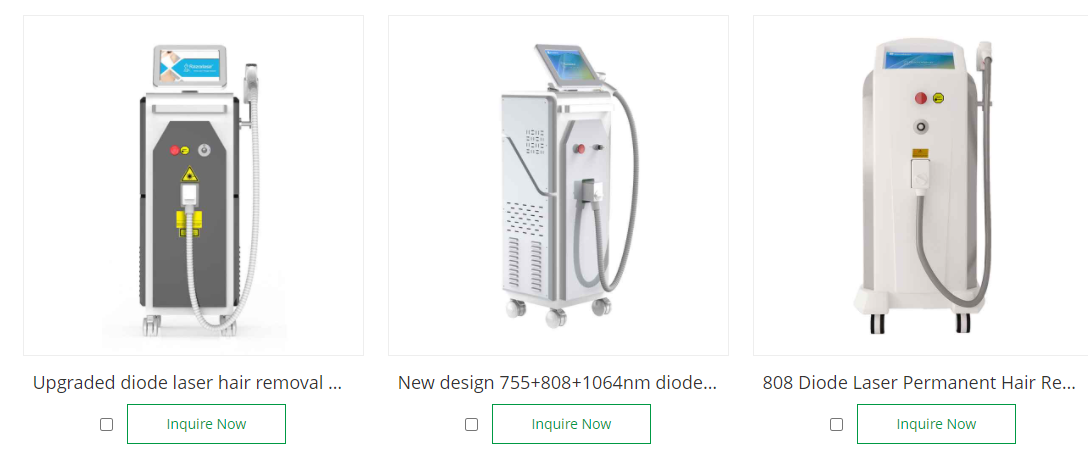Laser hair removal machine is an instrument that uses the principle of selective thermodynamics to select appropriate power, energy density and light spot to treat excess hair according to different characteristics of patients.
working principle
Laser hair removal methods can be divided into 3 categories:
1. Laser hair removal without selective damage, such as CO2 laser hair removal, is time-consuming and prone to scarring;
2. Photodynamic therapy, such as oral or topical α-aminocaproylpropionic acid followed by laser irradiation, this method seems feasible in theory, but has little clinical application;
3. Selective photothermal hair removal, namely laser and intense pulsed light hair removal.
The principle of modern laser hair removal machines is based on the principle of "selective photothermolysis" proposed by American doctors Aderson and Parrish in 1983: a certain wavelength of laser light passes through the epidermis, enters the dermis, and is selectively absorbed by the hair and hair follicles. The melanin granules of the hair are absorbed, resulting in a photothermal effect, and the heat energy in the hair is conducted to the surrounding, completely destroying the "hair roots" such as hair follicles and stem cells, resulting in permanent hair removal. The normal tissue around the hair follicle does not absorb the laser because it does not contain melanin particles, so the effect is very small and generally does not cause paralysis.
Lasers and light sources for laser hair removal machines
When using the principle of "selective photothermolysis" for laser hair removal, the laser wavelength and pulse width should ensure that the laser hits the hair follicle without damaging the adjacent tissue. Clinical studies have shown that the longer the wavelength, the deeper the penetration, the smaller the scattering, but the worse the absorption of melanin, so the energy will be stronger, but the epidermis cannot be damaged; the pulse width is smaller than the TRT (thermal relaxation) of the hair follicle. Time) is effective, and TRT larger than the epidermis is safe; the larger the spot size, the deeper the penetration; at the same time, active skin cooling should be used to protect the epidermis and relieve pain. When the wavelength is less than 600nm, the laser is mainly absorbed strongly by hemoglobin and protein, and when the wavelength is greater than 1100nm, the laser is mainly absorbed by the water in the body tissue, and the light is transparent when the wavelength is in the range of 600nm~1100nm. Therefore, people usually choose lasers with wavelengths in the range of 600nm to 1100nm for hair removal. Lasers and intense pulsed light sources used for hair removal mainly include long-pulse ruby laser (694nm), long-pulse alexandrite laser (755nm), semiconductor laser (800nm), long-pulse Nd:YAG laser (l064nm), intense pulse incoherent broadband Light source (590~1200nm), etc.
1. Long Pulse Ruby Laser
694nm ruby laser is strongly absorbed by melanin. This laser has 15% to 20% of the energy that can penetrate the entire dermis layer, and the hair with melanin in the dermis and deep layers can absorb the energy of the laser, causing the hair follicles to overheat and be damaged. The normal tissue around the hair follicle has a very low light absorption rate at 694 nm. When the pulse width is constant, the selective photothermal damage to the hair follicle can be achieved without damaging the surrounding normal tissue.
2. Long-pulse alexandrite laser
The 755nm alexandrite laser is similar to the ruby laser, except that it has slightly stronger penetration and lower melanin absorption because it has a slightly longer wavelength
3. Semiconductor laser
The penetration depth of the semiconductor laser system in the skin tissue is deep, more than 5mm, the scope of action can reach the deep dermis and subcutaneous adipose tissue, and can effectively penetrate the epidermis to the dermis hair follicle tissue, thereby destroying any part of the human body and depth of hair. The epidermis absorbs very little laser energy, so no hyperpigmentation occurs.
4. Long-pulse Nd:YAG laser
The wavelength of the long-pulse Nd:YAG laser is 1064nm and can penetrate 5-7mm. Due to the low affinity of melanin for the 1064 nm laser, exogenous chromophores (such as carbon smears) are often used for treatment. The laser spot scans the entire treatment area until visible carbon particles are removed. The disadvantage is that sometimes the carbon particles cannot reach the hair bulb and affect the therapeutic effect. For example, if the sweat glands and sebaceous glands are contaminated with carbon particles, they are easily damaged, and the clinical effect is not ideal. Recently, a long-pulse-width laser with a wavelength of 1064 nm has been clinically reported for hair removal without the need for carbon smears before surgery. Because epidermal melanosomes are very sensitive to short-pulse (<1ms) lasers, and long-pulse (≤200ms) lasers can allow the application of high-energy lasers to effectively heat the inner and outer hair root sheaths and hair growth areas without affecting the Epidermal melanosomes, so it can be safely used in the treatment of black skin.
5. Intense pulsed light
High-intensity pulsed light is not a laser light source, but a non-continuous light source with multiple wavelength combinations. Its wavelength is between 550 and 1200 nm, and it can penetrate 1.3 mm. The treatment parameters can be adjusted according to skin color or hair color. Theoretically, broad-spectrum wavelength light source systems increase the absorption of light by non-target objects, thus increasing adverse reactions.

Features of Laser Hair Removal Equipment
1. Long-pulse ruby laser: wavelength of 694m, which is the shortest wavelength in clinical hair removal lasers (not commonly used at present). Short wavelength and limited penetration depth, suitable for patients with light skin and dark hair, but limited effect on deeper hair follicles. It has strong selective absorption performance of melanin, energy is not only absorbed by melanin in hair follicles, but also absorbed by melanin in epidermis, which is easy to cause epidermal damage.
2. Long-pulse alexandrite laser: wavelength 755nm, the penetration depth is deeper than that of ruby laser, it is the most common hair removal laser in clinic, the treatment effect is good, the adverse reactions are relatively few and short-lived, there are erythema reactions, skin pigmentation, folliculitis, etc. , mainly seen in patients with darker skin or due to cold compresses on the treatment area after depilation.
3. Semiconductor laser: The wavelength is 800nm, which is one of the ideal laser hair removal systems with the most clinical applications. The penetration depth is deeper than that of ruby laser and emerald laser, and hair follicle melanin absorbs photons at 800 nm relatively strongly, which can effectively destroy hair follicles. Compared with red and alexandrite lasers, epidermal melanin absorbs less energy of semiconductor 800nm laser and has relatively few adverse reactions. Semiconductor lasers have low cost, high reliability and small size.
4. Long pulse laser: wavelength 1064nm, deep penetration, so it is especially suitable for patients with darker skin. The absorption of melanin for this wavelength is reduced, the hair follicle cannot be completely destroyed, and the hair will continue to grow. At the same time, the melanocytes of the hair follicle are destroyed, and the production of melanin is reduced, causing the growing hair to turn white, so the treatment requires high energy enough to destroy the hair follicle. .
5. High-intensity pulsed light: High-intensity pulsed light is not a laser light source, but a non-continuous, multi-wavelength light source with a wavelength in the range of 550-1200m. Its cooling system is good, the probability of skin trauma is low, and the side effects are also small. . It takes multiple courses to achieve the hair removal effect, and its hair removal effect is slightly inferior to laser
Factors Affecting Hair Removal Results
1. Selection of laser type (ie wavelength): When choosing what wavelength of hair removal laser, two factors need to be considered, one is the penetration depth of the laser; the other is the selectivity of target absorption. Due to the deep part of the hair bulb, it is decided to use a laser light source with a longer wavelength and deeper penetration for treatment. If the laser does not penetrate or penetrates too shallowly to reach the hair growth area, it will be difficult to see results. Generally, the penetration depth of laser increases with the increase of wavelength. Research shows that the ideal wavelength for destroying hair follicles is about 700nm. Another way to increase the penetration depth of the laser is to increase the spot, which can reduce the loss of the laser in the tissue and make the laser penetrate deeper into the skin. In addition, the size of the spot also affects the speed of treatment.
2. Determination of parameters: Laser hair removal is affected by various parameters such as its wavelength, spot, pulse width and energy, but the ideal value of each parameter is still unknown. According to the principle of selective photothermal action, while ensuring the selective absorption of melanin by light waves, the wavelength should be as long as possible. Theoretically, the curative effect can be improved by lengthening the laser pulse width to make it close to the thermal relaxation time of the hair follicle. Because the longer the pulse width, the less likely it is that tiny structures in the epidermis, such as melanosomes, are damaged, while relatively larger structures, such as melanosomes in hair follicles, are more vulnerable. It is generally believed that the ideal laser pulse width for hair removal should be between the thermal relaxation time of the epidermis (3-10ms) and the thermal relaxation time of the hair follicle (40-100ms).

Operation steps of laser hair removal equipment
The technical operation of laser hair removal seems to be very simple, but the experience of the operator affects the treatment effect. Although the operation of each machine will vary, generally the following steps should be included:
1. Investigate the medical history, examine the recipient, analyze the skin type, and check the hair condition.
2. Turn on the power and preheat the machine.
3. Preparation of the treatment area: The hair should be shaved before treatment, because the visible hair will damage the epidermis due to the high heat caused by the laser burning, and it can also cause irreversible damage to the laser guide head and cause unpleasant odor, but mechanical equipment cannot be used. Plucking or waxing for hair removal. In addition, the area should be cleaned to remove grease and dirt.
4. Set the treatment parameters and perform the trial treatment.
5. Get the best parameters and complete the whole treatment.
6. Check the reaction after treatment and explain relevant precautions.
Precautions for the use of laser hair removal equipment
1. During the treatment, both the doctor and the patient should wear laser protective glasses to prevent the eyes from being damaged by the laser.
2. The overlapping of the spots should not be too much. Repeated irradiation will aggravate skin damage. If the spacing is too wide, the treatment effect will be affected.
3. When using semiconductor laser hair removal, such as using cooling hand tools or hair removal under intense pulsed light, a certain pressure should be applied to the hand tool during the treatment, so that the hand tool can maintain good contact with the skin, and it can also drive away local blood and reduce hair loss. Oxyhemoglobin absorbs laser energy.










